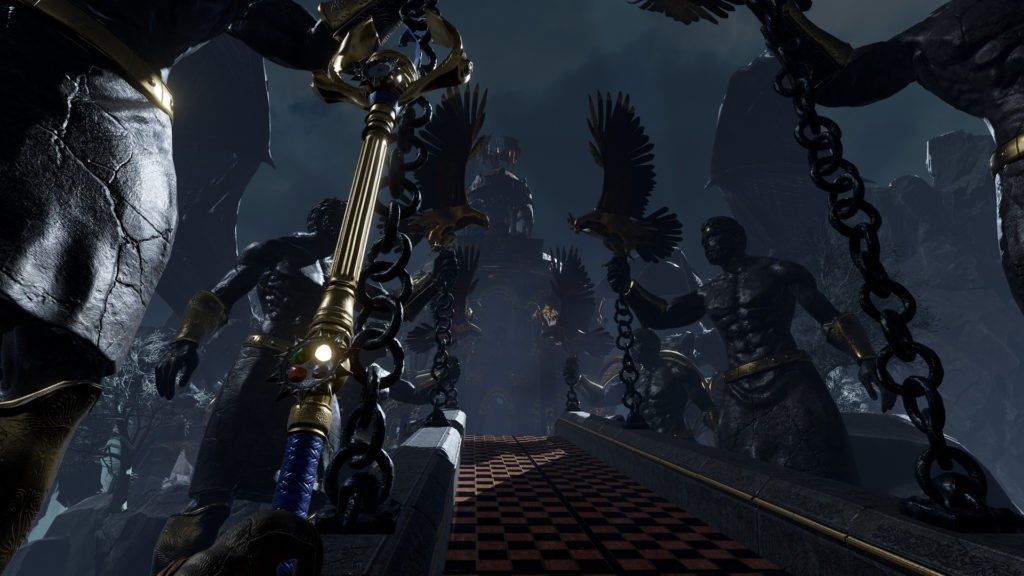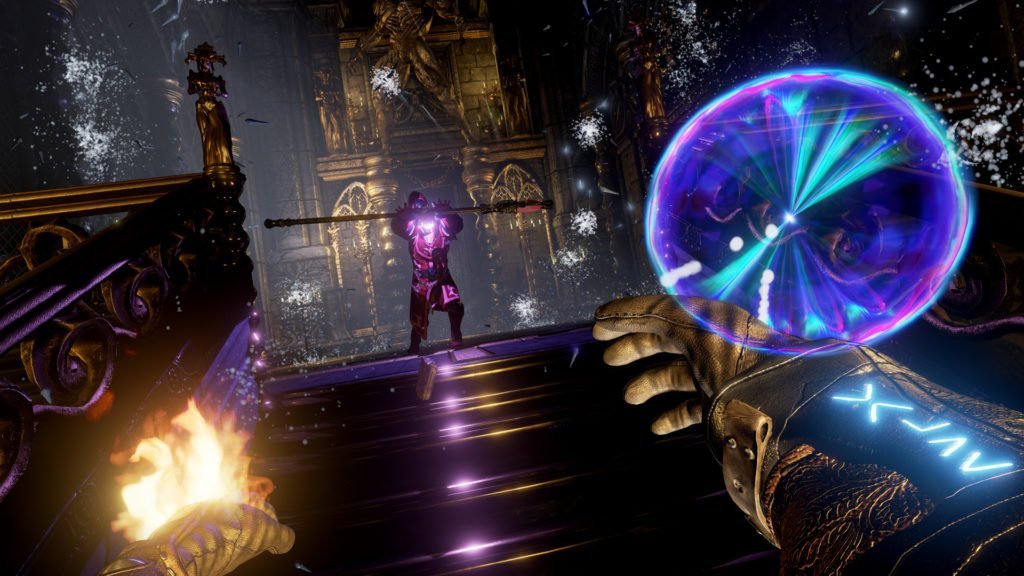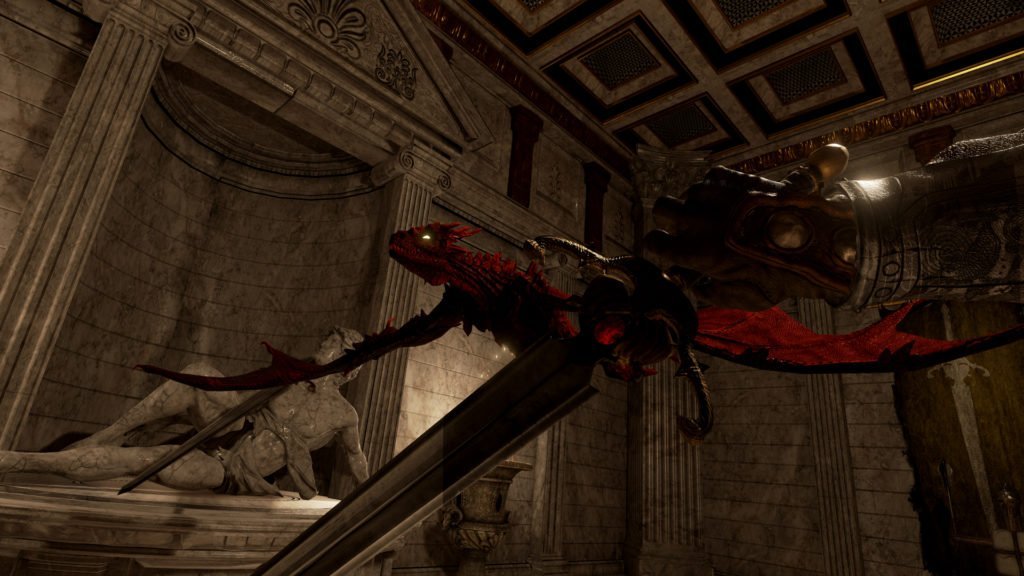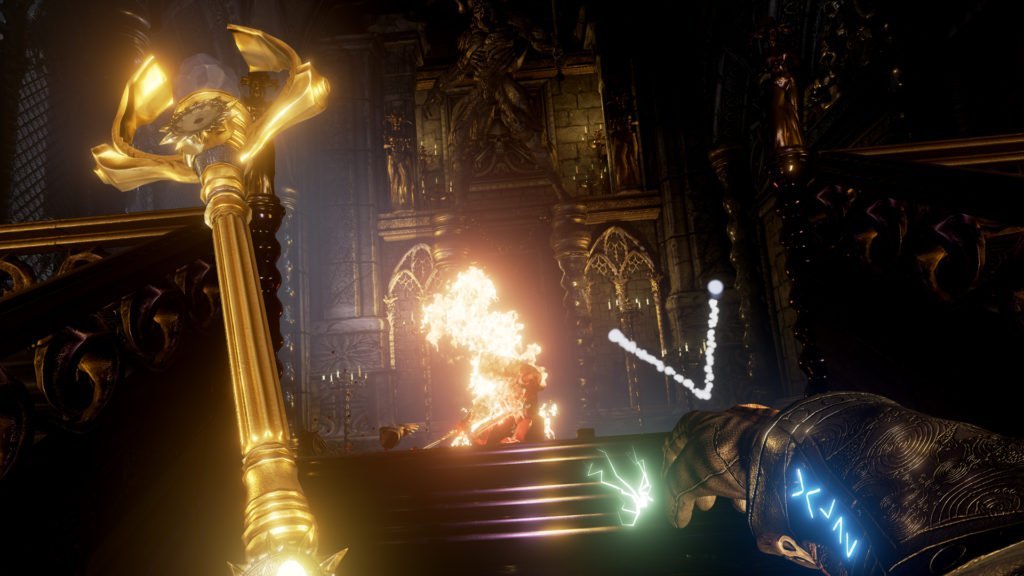HELM Systems’ upcoming game The SoulKeeper VR sounds like an HTC Vive owner’s dream. A realistic, gritty RPG going after total immersion, with a system where you have to make specific movements with your hand to cast different spells? Sign me up. Unfortunately, the core design of the game is poor and undermines its good ideas, creating what is ultimately an awkward experience.
The SoulKeeper VR is a first person, room-scale RPG for the HTC Vive, featuring both melee and spell casting systems. It is actually a spin-off of their unreleased episodic, open-world RPG, The SoulKeeper — which is a non-VR game — but both games will be standalone products. The version of The SoulKeeper VR that I played is an alpha build, and is quite a short experience from beginning to end. It even labels itself as a “demo” once installed in the Steam library, and altogether a single playthrough of all of the available content, including the tutorial, took about 30 minutes. This certainly doesn’t spell bad news for the game, as it has yet to even receive a release date. But it does mean that this is really more of a tech demo, showing off a few systems, rather than showing off part of a larger game.

There is no narrative present in this build of the game; you simply move through a couple of rooms and deal with the enemies you are presented with. This means that the entire experience is focused on moving and attacking, both of which are things that every VR developer is still trying to perfect. In The SoulKeeper VR, you have three options for movement. You can physically walk around in the room-scale style that Vive owners are used to, you can teleport, or you can use the track pads on the Vive controllers to mimic dual analog style controls and move freely without ever lifting a foot.
The track pad option will be disorienting and even sickening for many people, since seeing yourself ‘walk’ forward without actually feeling any movement in your body is quite the hurdle for your brain to get over. Even as someone who has been playing VR games for over a year, my first playthrough of the demo was a little nauseating. After about 20-30 minutes I was used to it, and able to move that way with no issues, but I still preferred the other forms of movement. The track pads just feel too slow. You can physically walk faster, or you can just teleport, so why wouldn’t you always do that? Providing players with more choices for movement is a good thing however, and more VR developers should include these options as a default, even if some people won’t use one of them.
There are also three different ways to deal with enemies: your sword, your staff, and casting spells. The sword is simple enough, and works just how you expect it to in any other VR game. You pull it off of your back with your right hand to equip it, you start whacking bad guys, and that’s all there really is to it. This simplicity would be fine if it weren’t so easy to trivialize the game with it. The SoulKeeper VR is aiming to be the most immersive RPG for VR, and part of that means enemies reacting realistically in combat. So when you strike a foe with your sword, they recoil in response. While this certainly looks good, it takes away almost all challenge from the game. Since enemies can’t attack while recoiling, all you have to do is stand in front of them and keep tapping them on the head with your sword. They will never be able to hurt you, and they will die rather quickly.

The spell casting is a little more interesting, although also more fun to look at than it is to use. When your sword isn’t equipped, you can use your right hand to cast spells by drawing symbols in the air while holding down the right trigger. Once the symbol is drawn, just aim your right hand where you want to shoot, and press the right trigger to unleash your spell. There are five different spells, all projectile attacks, and the symbols for each are drawn onto your wrist so that you can always look to see what they are.
This idea sounds great on paper. And when trying it out on the target dummies in the tutorial it felt amazing, like the developers were truly taking advantage of the fact that this is a VR game. But in combat with actual enemies it is tedious and frustrating. To simply shoot a fireball at an enemy you have to put your sword away if you have it out, draw a little arrow symbol, wait for the vibration cue to confirm that you drew the symbol correctly, aim your shot, then fire. All the while the enemy is also casting spells at you. And if you miss, or if your spell didn’t kill your target, then you have to do it all over again, every single time you want to fire a projectile. It’s a system that really does feel cool to use, but is impractical against real enemies.
The staff is a mix between the sword and spell casting. Equipped the same way as the sword, but in your left hand instead, it too can be used as a melee weapon. But you also have four different spell options to choose from, which you select by lightly touching the track pad in one of the four corners. Then, pulling the left trigger activates the spell. One of the spells is the teleport, meaning you have to have the staff equipped to move this way. The others are a fire spell that continuously shoots flames as long as you hold the trigger, a light spell that illuminates dark areas, and a shield spell that puts a protective bubble around you for about five seconds.
Again, the staff seems like something that was designed because of how cool it seemed on paper. But, in practice, it is clumsy and unnecessary. Even with the staff constantly equipped I had difficulty using it to cast the right spell. In the heat of combat it is hard to tell what spell you currently have selected. And since there’s no actual button press involved in selecting a spell, I would often pick the wrong one by accident and end up teleporting somewhere when I meant to put up a shield. The staff seems to serve no real purpose other than to add more to the game. There is already a melee weapon, and if the reason the staff can be used for melee is so that you can cast spells and use melee at the same time, then why have the sword? And there is already a way to cast spells, and one of the spells on the staff is even a combat spell, making it all the more confusing and redundant. Why is that spell on the staff instead of cast from your right hand like all the other combat spells? There is little consistency to it.

Visually, the game looks nothing short of incredible, opting for an ultra-realistic visual style rather than the stylized, cartoonish graphics of some other VR games. Though, as much as this adds to the immersion of the game, it also takes away from it. When standing in a room with no other people or creatures in it, it is possibly the most immersed I’ve felt in a game. It looks astonishingly real. However, as soon as enemies enter the screen, that sense of immersion is completely broken. With the enemies, the realistic visuals create an off-putting uncanny-valley effect. As soon as they move or react even slightly unrealistically (which happens often since in VR you can manipulate them in an almost infinite number of ways) the game goes from feeling gritty and real to goofy and broken. Say what you will about cartoonish graphics, but they help deal with issues like this, as any weird VR wonkiness would feel almost appropriate given the artistic style.
There are a couple small things The SoulKeeper VR does well, though. One is showing your wrists and forearms. This may seem minor, but when aiming for complete immersion, seeing a pair of floating hands in front of you can really take you out of it. By modeling a pair of gauntlets all the way up to the elbow, more often than not you don’t see any disconnected, floating arms, and it goes a long way to making you feel like you’re there. The other thing is graphical settings. Surprisingly, many VR games don’t let you fine tune the graphics beyond simple high, medium, or low settings. In The SoulKeeper VR, you can modify everything from shadows to anti-aliasing, and even post-processing effects. This means that even though the game is a graphical powerhouse, you can adjust it to keep the aspects you want and lower the ones you don’t if you are having difficulty running the game.

The SoulKeeper VR has a long way to go if it wants to be a landmark VR experience. A lot of its ideas are implemented really well as VR mechanics, but only in a vacuum. Nothing makes this more apparent than the fact that I was having huge amounts of fun messing around with all of the combat and spell systems during the tutorial, but as soon as I moved on to facing actual enemies everything fell apart and the game became clunky and frustrating. Hopefully HELM Systems can figure out how to make these mechanics fun to use, not just in an empty room, but also in the actual game, because in its current state the game isn’t worth playing.
The SoulKeeper VR will be coming to Steam Early Access, but there is currently no specific release date.

